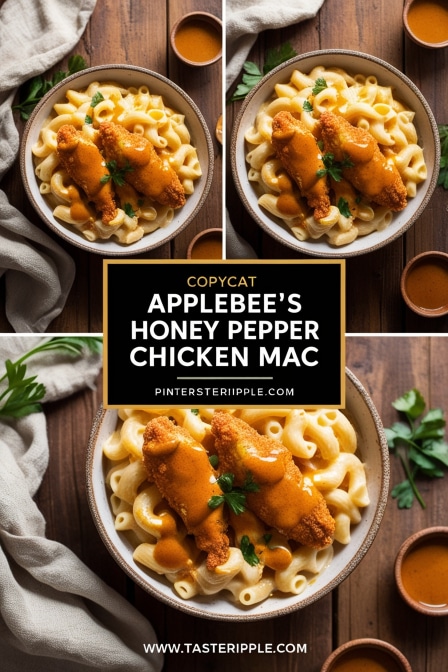There’s a curious thing about restaurant food. You take a bite, sigh at the flavors, and swear there’s no way it can be made at home without an industrial stove or a pantry of mysterious powders. Applebee’s Honey Pepper Chicken Mac is one of those plates. Creamy macaroni, crispy fried chicken strips, and that golden, sticky-sweet sauce that clings like a secret. The first time I tried it, I wondered—what exactly is in that honey pepper glaze? And how does it walk the line between comfort and fireworks?
That’s the charm of this dish. It’s comfort food dressed in casual diner clothes, but built with layers of flavor that chefs recognize as deliberate choices. There’s the creamy white cheddar mac, rich but not heavy. The fried chicken tenders, battered for crunch but soft inside. And finally, the sauce. A drizzle that wakes the whole thing up with honey sweetness, a little pepper bite, and tang from vinegar. A plate that feels like indulgence, but also oddly balanced if you think carefully.
Today we’ll break this recipe down, piece by piece. Not just so you can copy it, but so you can understand why it works. And maybe even make it better than the restaurant does, right in your own kitchen.
Why This Recipe Stands Out
The uniqueness of Applebee’s Honey Pepper Chicken Mac lies in contrast. Soft pasta meets crispy chicken. Sweet sauce meets sharp cheese. Every bite is designed to play tug-of-war on your tongue. It’s not just indulgent—it’s engineered indulgence.
What makes it special is that nothing here is wasted. The macaroni isn’t filler, it’s creamy support. The chicken isn’t plain protein, it’s a textural anchor. And the glaze isn’t garnish—it’s the flavor thread tying it all together. Chefs know balance is the secret to any crowd-pleasing dish, and this one nails that harmony almost too perfectly.
Ingredients and Substitutions
A lot of home cooks try to mimic restaurant recipes by throwing together whatever’s on hand. Sometimes that works. Here though, ingredient choice changes the outcome dramatically. White cheddar versus yellow cheddar? You’ll taste the difference. Cornstarch versus flour in batter? Changes the crunch. Even honey brand matters more than most folks realize.
Here’s a table that organizes what you’ll need, with room for smart swaps.
Ingredient Table
| Ingredient | Measurement | Notes & Substitutions |
|---|---|---|
| Boneless chicken breasts | 1 lb | Chicken tenders or thighs also work; thighs give juicier bite |
| All-purpose flour | 1 cup | Can use gluten-free flour mix |
| Cornstarch | ½ cup | Essential for crispy coating; potato starch is a fine sub |
| Eggs | 2 large | For binding batter |
| Buttermilk | 1 cup | Can sub with milk + 1 tbsp lemon juice |
| Panko breadcrumbs | 1 cup | Regular breadcrumbs okay, but less crunchy |
| Macaroni pasta | 1 lb | Any short pasta works—cavatappi holds sauce best |
| Butter | 4 tbsp | Unsalted preferred |
| All-purpose flour (for roux) | 3 tbsp | Thickens cheese sauce |
| Milk | 2 ½ cups | Whole milk gives creaminess, skim makes it thinner |
| Heavy cream | 1 cup | Adds richness; can sub half-and-half |
| White cheddar cheese | 2 cups, shredded | Sharp white cheddar for flavor depth; yellow cheddar is milder |
| Parmesan cheese | ½ cup, grated | Adds salt and nutty edge |
| Honey | ½ cup | Clover honey for floral tone; darker honey is more robust |
| Soy sauce | 3 tbsp | Provides umami base |
| Apple cider vinegar | 2 tbsp | Gives tang; rice vinegar is softer alternative |
| Black pepper | 1 tsp, freshly cracked | Can use white pepper for subtler bite |
| Red pepper flakes | ½ tsp | Optional, for added heat |
| Olive oil | 2 tbsp | For sauce consistency |
| Salt | To taste | Adjust at end |
Notice the role of each ingredient isn’t accidental. Buttermilk isn’t just moisture—it tenderizes chicken fibers. Cornstarch doesn’t just bulk up the flour—it prevents soggy crust. Freshly cracked black pepper blooms differently in hot honey glaze than pre-ground dust from a jar. Professionals know these small differences accumulate into big flavor.
Step-by-Step Instructions
Cooking this dish at home isn’t complicated, but rushing or skipping details will flatten it. Restaurants don’t cut corners, and neither should we if the goal is authenticity.
Step 1: Marinate the Chicken
Slice chicken into strips. Place in bowl with buttermilk and a pinch of salt. Let sit at least 30 minutes, ideally 2 hours. This ensures the meat stays juicy when fried. Don’t skip this, unless you enjoy dry chicken.
Step 2: Bread the Chicken
Set up three bowls: flour + cornstarch seasoned with salt and pepper, beaten eggs, and panko crumbs. Dip each strip through flour, egg, then crumbs. Press firmly so breading clings. Let rest 10 minutes before frying—this is how you avoid that dreaded “naked chicken” where coating slips off.
Step 3: Fry the Chicken
Heat oil to 350°F. Fry strips in small batches until golden, about 5–6 minutes. Drain on rack, not paper towel. Why? Steam builds under fried food if laid flat on paper, softening the crust you worked for. Professionals never smother their fried items.
Step 4: Cook the Pasta
Boil pasta in salted water. Save ½ cup of pasta water for later. Drain but don’t rinse—the starch helps sauce cling. Rinsing pasta is one of those home mistakes that chefs quietly cringe about.
Step 5: Make the Cheese Sauce
In saucepan, melt butter. Stir in flour to form roux, cook 1–2 minutes. Slowly whisk in milk and cream. Simmer until thickened. Off heat, stir in cheddar and Parmesan until smooth. If too thick, loosen with pasta water. If grainy, your cheese overheated—always add cheese off the boil.
Step 6: The Honey Pepper Sauce
In small pan, warm honey, soy sauce, vinegar, olive oil, and cracked pepper. Let it bubble for 2–3 minutes until glossy. Taste. If it’s flat, add more vinegar. If too sharp, stir in extra honey. Balancing sweet and tang is the art here, not the recipe.
Step 7: Assemble
Toss pasta with cheese sauce. Place fried chicken strips on top. Drizzle generously with honey pepper glaze. Garnish with fresh parsley or even a sprinkle of crushed red pepper for color. Serve hot, before sauce cools and stiffens.
Common Mistakes and How to Dodge Them
- Overcrowding fryer pan = soggy chicken. Always fry in batches.
- Using pre-shredded cheese = gritty sauce. Anti-caking powder in bagged cheese doesn’t melt right.
- Adding cheese too early = split sauce. Patience saves creaminess.
- Forgetting to season pasta water = bland dish. Pasta absorbs seasoning as it cooks, not after.
For spicier version, toss in cayenne or hot honey instead of plain. For milder, reduce pepper and lean into floral honey. Recipes should bend to taste, not imprison it.
Cooking Techniques and the Science Behind Them
Why buttermilk marinade? Its acidity breaks protein bonds in chicken muscle, creating tenderness. That’s culinary chemistry in your mixing bowl.
Why cornstarch in breading? It inhibits gluten formation, keeping coating light and crisp instead of tough.
Why roux-based cheese sauce? Because flour binds fat and liquid, preventing the oily separation you see when amateurs just dump cheese into milk. This is controlled emulsification.
And the honey glaze—heating honey changes flavor molecules slightly, deepening caramel tones. Pepper oils bloom in the warm liquid, creating fragrance sharper than if sprinkled raw. Every step here has science behind it.
Storage and Reheating
Store leftovers in airtight container up to 3 days. To reheat pasta, add splash of milk before microwaving or warming on stovetop—it revives sauce. Chicken reheats best in oven at 350°F for 10 minutes; never microwave unless you want chewy crust.
Variations and Substitutions
- Gluten-free: Use GF flour blend and GF pasta. Cornstarch works the same.
- Vegan: Swap chicken with crispy tofu, use plant milk and vegan cheese. For glaze, maple syrup can mimic honey.
- Spicy twist: Use chili honey or drizzle with sriracha before serving.
- Lighter version: Bake chicken instead of frying, use reduced-fat milk and cheese. Not the same indulgence, but lighter on calories.
Tools That Matter
Cast iron skillet holds frying heat steady. Whisks prevent lumps in roux. Microplane grater creates cheese that melts instantly compared to store-shredded blocks. Each tool isn’t optional fluff—it’s outcome insurance.
Serving and Pairing Suggestions
This dish is heavy, so pair smart. Bright salads with vinaigrette cut the richness. Roasted broccoli or asparagus adds crunch and bitterness for contrast. Drinks? A crisp lager or citrusy white wine balances honey’s sweetness. Even sparkling water with lemon works.
For plating, pile mac in wide shallow bowl, layer chicken on top like a crown, then drizzle glaze in zigzags for visual drama. A dusting of parsley keeps it from looking monotone beige.
Best Time to Serve
This isn’t Tuesday lunch food—it’s weekend comfort, game-day indulgence, or family dinner centerpiece. Serve when people can linger, when calories don’t need accounting. It’s food for gathering, not snacking.
Conclusion
Copycat Applebee’s Honey Pepper Chicken Mac isn’t just a recipe, it’s a lesson in how contrast builds satisfaction. Sweet plus savory. Creamy plus crunchy. Tender plus crisp. Once you see those balances, you can replicate the trick anywhere.
If something fails, check your details. Cheese too grainy? Heat too high. Chicken soggy? Oil temp too low. Sauce flat? Adjust acid and honey. Cooking isn’t blind faith—it’s correction until harmony appears.
Master this dish, and you’re not just copying Applebee’s. You’re learning professional tricks of marination, breading, emulsification, and sauce balancing. And that knowledge carries into every future dish.
FAQs
1. Can I bake the chicken instead of frying?
Yes, but expect less crunch. Bake at 425°F for 20 minutes, flipping once. Use panko for best texture.
2. What’s the best cheese if I can’t find white cheddar?
Gruyère or Fontina both melt beautifully and bring deep flavor. Yellow cheddar works but is sharper and less smooth.
3. Can the honey pepper sauce be made ahead?
Absolutely. Store in fridge up to a week. Rewarm gently before drizzling.
4. How do I keep cheese sauce smooth when reheating?
Add splash of milk and reheat slowly. High heat causes sauce to separate.
5. Is there a lighter version of this recipe?
Yes—bake chicken, use half-and-half instead of cream, and reduce cheese quantity. Still tasty, but less decadent.

